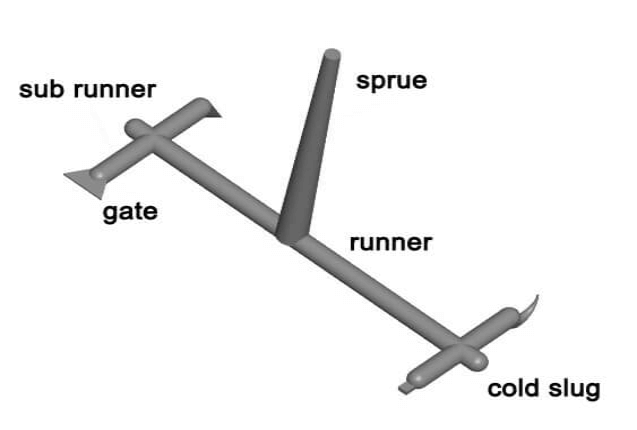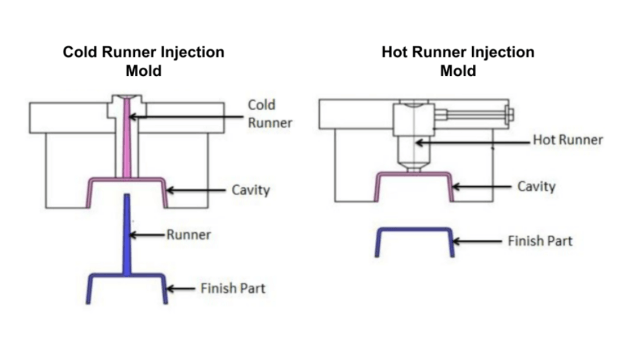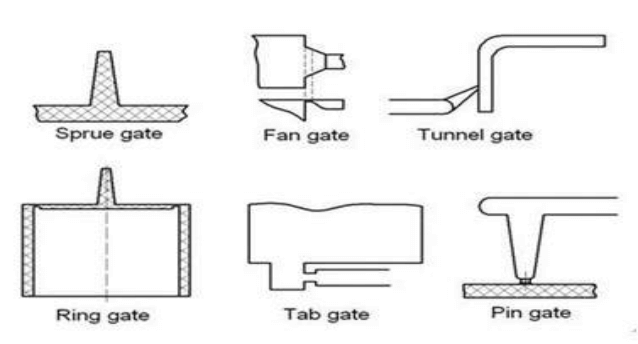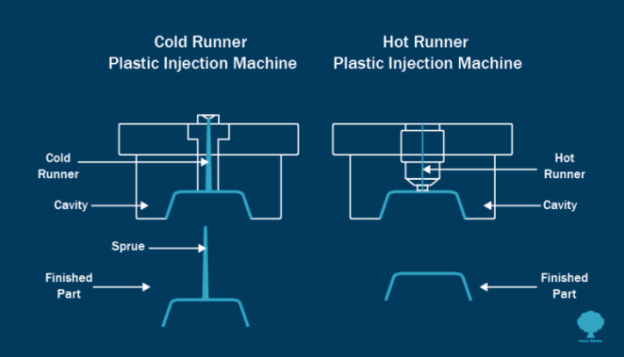


In the world of plastic injection molding, sprues, runners, and gates play vital roles in the manufacturing process. To truly grasp their importance, it is crucial to comprehend the meanings of these terms and how they are interconnected. This blog post aims to provide a comprehensive understanding of these components and their role in the runner system. Let's begin with sprues, which are channels that enable the flow of molten plastic from the Dakumar injection molding machine to the mold cavity. Sprues serve as the main corridors or doorways through which the plastic material enters the mold. Their controlled distribution helps minimize the occurrence of air bubbles and ensures a uniform filling of the cavities. In this way, sprues act as a technique to achieve high-quality plastic parts during the manufacturing process.
Moving on to runners, they are the channels that connect the sprues to the individual cavities within the mold. Runners serve as pathways for the material to reach the various parts of the mold. They are available in different types, depending on the specific requirements of the injection molding machine and the plastic parts being produced. The design of the runner system is crucial for efficient and scalable manufacturing, as it determines the flow and distribution of the molten plastic.
Lastly, let's discuss gates, which are the connecting points between the runners and the mold cavities. Gates control the injection of the plastic material into the cavities. They are strategically placed to ensure proper filling while minimizing material waste and maintaining repeatable production. Different types of gates are used based on the characteristics of the plastic, the mold design, and the desired outcome. Understanding the basics of gate types is essential for achieving optimal results in the injection molding process. It is important to note that these terms—sprues, runners, and gates—are not interchangeable, and each serves a specific purpose in the plastic injection molding services. The distinction between them is crucial for achieving successful and efficient manufacturing outcomes. This article has aimed to provide a concise yet comprehensive explanation of their meanings and roles.

In the realm of injection molding, sprues are an integral component that plays a crucial role in the manufacturing process. A sprue is a channel or passageway through which molten plastic material is forced out from the injection molding machine. It serves as the entry point for the plastic, connecting directly to the nozzle of the machine. Sprues are also known as the primary channel or the widest end of the system of runners. The journey of the molten plastic material begins with the reciprocating screw inside the barrel of the injection molding machine. As the screw rotates and moves forward, it pushes the molten plastic material towards the nozzle. The sprue, located at the smallest and shortest end of the system of runners, is the first point of contact for the plastic. It flows through the sprue and enters the entire assembly structure, including the mold cavity.
To ensure proper functionality, the sprue needs to be sealed tightly within the mold. The sprue bushing, located on the A plate, is responsible for maintaining a secure connection between the injection molding machine and the mold. It acts as a circular passageway that transports the molten plastic material from the nozzle to the mold cavity. The fastener sprue bush, along with bolts, holds the sprue bushing in place and ensures a reliable connection.
Gates, on the other hand, are openings within the injection mold that allow the plastic material to enter specific cavities. The design factors of the gates, such as their size, shape, and location, determine the material flow path and affect the quality of the desired product. The presence of gates limits the effectiveness of the sprue in controlling the material flow, as the plastic is infused directly into the mold cavities through these openings. It is important to note that sprues can be repurposed and recycled. In some cases, the sprue can be regrind and reused as part of the plasticating capacity. This not only reduces the amount of lost material but also contributes to a more sustainable manufacturing process. Moreover, the length and cross-section of the sprue can impact the solidification and cooling time of the plastic, influencing the overall production cycle.
In the realm of plastic injection molding, the concept of sprue as waste material plays a significant role in the manufacturing process. When a shot of molten plastic is injected into the mold cavity, it fills not only the intended parts but also creates excess plastic material in the form of sprues. Sprues are the channels or pathways that connect the runners and gates, ensuring the proper flow of the plastic throughout the mold.
Once the injection molded plastic parts have solidified and taken shape within the mold, the sprue becomes an attached extension. These sprues are then carefully trimmed off from the finished parts. Although sprues may initially be considered waste material, their presence serves a purpose in the injection molding process. They prevent excessive pressure build-up and assist in the proper filling of the mold cavities.
The excess plastic material in the form of sprues can be repurposed and reused in various ways. This waste material can be recycled and utilized in other manufacturing processes. The recycling of sprues reduces the amount of plastic waste and contributes to a more sustainable production cycle.

In the context of injection molding, runners are channels that connect the sprue, gates, and mold cavities. They play a crucial role in facilitating the transfer of the injected molten plastic material from the machine nozzle to the mold. The design of runners is important for achieving efficient and high-quality production.
Runners come in various shapes and sizes, depending on the specific requirements of the molded parts and the mold design. Commonly used cross-section shapes for runners include round, semi-circular, parabolic, and trapezoidal. These shapes are carefully selected to balance the filling process and minimize pressure drop, ensuring the smooth flow of the material. Engineers and researchers, such as those at the National Taiwan University, have conducted studies to optimize the design of runners. They have explored factors such as runner lengths, diameters, and flow rates, aiming to reduce friction and heat generation during material flow. By improving runner design, engineers can achieve a more balanced and uniform filling of the mold cavities, resulting in improved part quality. Furthermore, the distance between runners in multi-cavity molds is critical to achieving simultaneous and equal material feeding. Design considerations such as runner length, diameter, and opening balance the filling time and minimize material waste. The goal is to create a runner system that compensates for differences in mold cavities, ensuring that all parts are filled properly and at a desirable rate.
Additionally, runners help prevent flashing, which refers to excess material escaping from the mold cavities. Proper runner design and management can effectively control the pressure and speed of material flow, reducing the occurrence of flashing and improving the overall quality of the molded parts.

In the field of injection molding, a gate plays a crucial role in the overall process. It is an essential entity that facilitates the material flow from the runner into the mold cavity during the filling process. Mold designers strategically determine the placement and shape of the gate to ensure proper material distribution and minimize potential defects. The gate is typically a small extension located at a critical point in the mold cavity. Its purpose is to constrict the flow of the molten plastic, which enhances the packing and reduces the chances of surface blemishes and part defects. By narrowing the entrance, the gate helps avoid excessive pressure and potential sink marks on the component surface.
The choice of gate location is significant as it influences the material flow pattern and the overall quality of the molded part. Mold designers consider factors such as wall thickness and material properties to determine the optimal gate placement. They aim to achieve a sufficient pressure drop to ensure the material is adequately packed into the mold cavity without causing any blemishes or marks.
During the filling process, the gate serves as a direct pathway for the injected material to enter the mold cavity. It controls the speed at which the molten plastic flows, allowing for a controlled and uniform filling. This controlled filling process helps prevent the occurrence of shrinkage holes or other undesirable part defects. To maintain the integrity of the molded part, the gate is designed to freeze and cut away from the main component after the material has sufficiently packed the mold cavity. This ensures that the gate does not remain attached to the final product, leaving a clean surface finish without any visible marks or blemishes.
When considering cold runner manual trim gates in the injection molding process, various gate types are available. These gates determine how the material flows into the molded parts. Manual trim gates provide the option to cut away excess material, resulting in finished products with precision.
Edge gates are a simple and effective type of gate used in injection molding. They offer several advantages due to their rectangular cross-section and strategic placement along the parting line of the mold. The design of edge gates allows for efficient material flow and minimizes pressure loss, resulting in high-quality molded parts with minimal part defects such as flow marks or air bubbles. Compared to side gates, edge gates are particularly useful when dealing with large amounts of material, as they ensure even distribution and facilitate easy trimming after molding. Overall, edge gates are a reliable choice for achieving consistent and precise molding results.
Tab gates, featuring a side entry, are an effective solution for achieving optimal results in injection molding. The design of these gates consists of an auxiliary tab section that enables the material to enter the mold cavity from the side. This configuration reduces the chances of filling defects and makes trimming easier as the tab gate can be left in place. By utilizing the side entry approach, tab gates facilitate efficient material flow and minimize potential challenges associated with harder-to-reach areas. Overall, tab gates with side entry offer a reliable and efficient option for achieving excellent molding outcomes.
Fan gates are a specialized type of gate that ensures even filling and enhanced control in the injection molding process. The design of fan gates resembles a reverse taper or a fan shape, which allows for precise distribution of the molding material into the mold cavity. Unlike simple edge gates, fan gates provide a larger opening, reducing the chances of jetting and associated part defects. This phenomenon leads to a smoother filling process, minimizing the risk of blemishes or defects on the molded part. With their unique design and precise control, fan gates offer an effective solution for achieving consistent and high-quality results in injection molding.
Direct sprue gates offer a simplified design for injection molding processes, although they come with certain trade-offs. The direct sprue gate serves as a direct connection between the sprue and the mold cavity, eliminating the need for runners. This simplicity in design allows for easy control of the material flow and injection pressure. However, the success of direct sprue gates is dependent on the machine itself and the mold designs. Incorporating direct sprue gates into molds with multiple cavities requires careful consideration to ensure consistent material flow and pressure control throughout the molding process. Despite the trade-offs, direct sprue gates provide a straightforward and efficient solution for molding operations that value simplicity and control over the use of additional runners.
Diaphragm gates, also known as disc-shaped gates, are specifically designed to minimize flow marks on molded parts with precision. These gates incorporate a round gap or opening, often in the form of a hollow cylindrical part, which allows for controlled material flow. The diaphragm gate design helps reduce the difficulties associated with trimming and provides a smooth transition without sharp edges. By implementing diaphragm gates, manufacturers can achieve high-quality parts with minimized flow marks, ensuring precise and aesthetically pleasing results.

Cold runner automatic trim gates exemplify efficiency in action. These gate types are designed to automatically remove excess material during the molding cycle, utilizing motion and ejection mechanisms.
Tunnel/submarine (sub) gates offer easy removal for seamless production in injection molding. These gates, featuring an angled tunnel or subgate, allow plastic to flow smoothly from the runner to the mold cavity. The strategic placement along the parting line improves de-gating and facilitates efficient trimming. The size and placement of tunnel/submarine gates can be optimized to enhance productivity and minimize gas trapping, ensuring high-quality molded parts. With their automatic removal features, these gates contribute to improved production processes and minimize limitations associated with gas trapping.
Cashew gates introduce an innovative approach to gate design in injection molding. These gates, often referred to as tunnel gates, feature a curved shape that allows for smooth material flow from the runner to the mold cavity. Positioned along the parting line, de-gating becomes easier, reducing the risk of breakage. The curved design of cashew gates provides a non-visible location for gating, ensuring a clean and aesthetically pleasing appearance on the trimmed and ejected parts. With their unique characteristics, cashew gates address challenges associated with difficult de-gating and minimize the potential for part breakage during the molding process.
When exploring hot runner gates for advanced molding, various gate types can be used in hot runner molds.
Thermal gates are a common gate type used in hot runner systems for injection molding. These gates leverage temperature control to direct the flow of material from the heated internal nozzle to the mold cavity.
Valve gates, a special type of hot runner gate, provide precision and flexibility in controlling material flow. These gates feature a moveable pin within the nozzle system, allowing for precise control over the opening and closing of the gate during the molding process. The unique design of valve gates enables accurate modulation of material flow, resulting in high-quality molded parts with consistent and uniform filling.
Mastering injection mold sprues, runners, and gates is crucial for achieving optimal results in the injection molding process. These important elements are essential components of an injection mold system, bringing together the molten plastic, injection machine, and mold cavity in a thermally efficient manner. Proper gate placement minimizes pressure drop and enables the molten plastic to flow smoothly into the mold cavity. Understanding the basics of sprues, runners, and gates allows product designers and mold manufacturers to make informed decisions about their placement, resulting in improved part quality, surface quality, material usage, and cycle times. Additionally, the use of multi-cavity molds, automatic degating, and direct sprue gates, along with additional gates, further enhance the efficiency and precision of the molding process. Mastering these concepts is key to achieving successful and efficient injection molding operations.